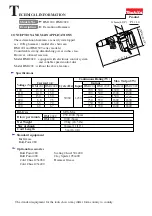
Operations
62
All SCPI commands are available through RS-232 programming. The EIA RS-232 standard defines the interconnections
between data terminal equipment (DTE) and data communications equipment (DCE). The electronic load is designed
to be a DTE and can be connected to another DTE such as a PC COM port through a null modem cable.
Note:
The RS-232 settings in your program must match the settings specified in the front panel System menu. Press
+
on the front panel to enter the
System
menu if you need to change the settings.
RS232 Data Format
The RS-232 data is a 10-bit word with one start bit and one stop bit.
Parity = None
Start Bit
8 Data Bits
Stop Bits
The number of start and stop bits are not programmable. However, the following parameters are selectable in the System
menu using the front panel
+
key.
Baud Rate
The System menu lets you select one of the following baud rates, which are stored in non-volatile memory: 4800, 9600,
19200, 38400, 57600, or 115200.
Parity
None
- eight data bits without parity
Even
- seven data bits with even parity
Odd
- seven data bits with odd parity
RS232 Flow Control
The RS232 interface supports the following flow control options. For each case, the electronic load will send a maximum
of five characters after hold-off is asserted by the controller. The electronic load is capable of receiving as many as fifteen
additional characters after it asserts hold-off.
•
CTS/RTS
: The electronic load asserts its Request to Send (RTS) line to signal hold-off when its input buffer is
almost full, and it interprets its Clear to Send (CTS) line as a hold-off signal from the controller.
•
XON/XOFF
: When the input queue of the electronic load becomes more than ¾ full, the instrument issues an X-OFF
command. The control program should respond to this and stop sending characters until the electronic load issues
the X-ON, which it will do once its input buffer has dropped below half-full. The electronic load recognizes X_ON
and X_OFF sent from the controller. An X-OFF will cause the electronic load to stop outputting characters until it
sees an X-ON.
•
NONE
: No flow control.
Flow control options are stored in non-volatile memory.
Содержание MDL4U Series
Страница 1: ......
Страница 25: ...Installation 25 Figure 2 9 Fuse Location Figure 2 10 Fuse Removal...
Страница 41: ...Operations 41 4 2 2 Module Panel Figure 4 8 Module Front Panel...
Страница 64: ...Specifications...
Страница 65: ...Specifications 65...







































